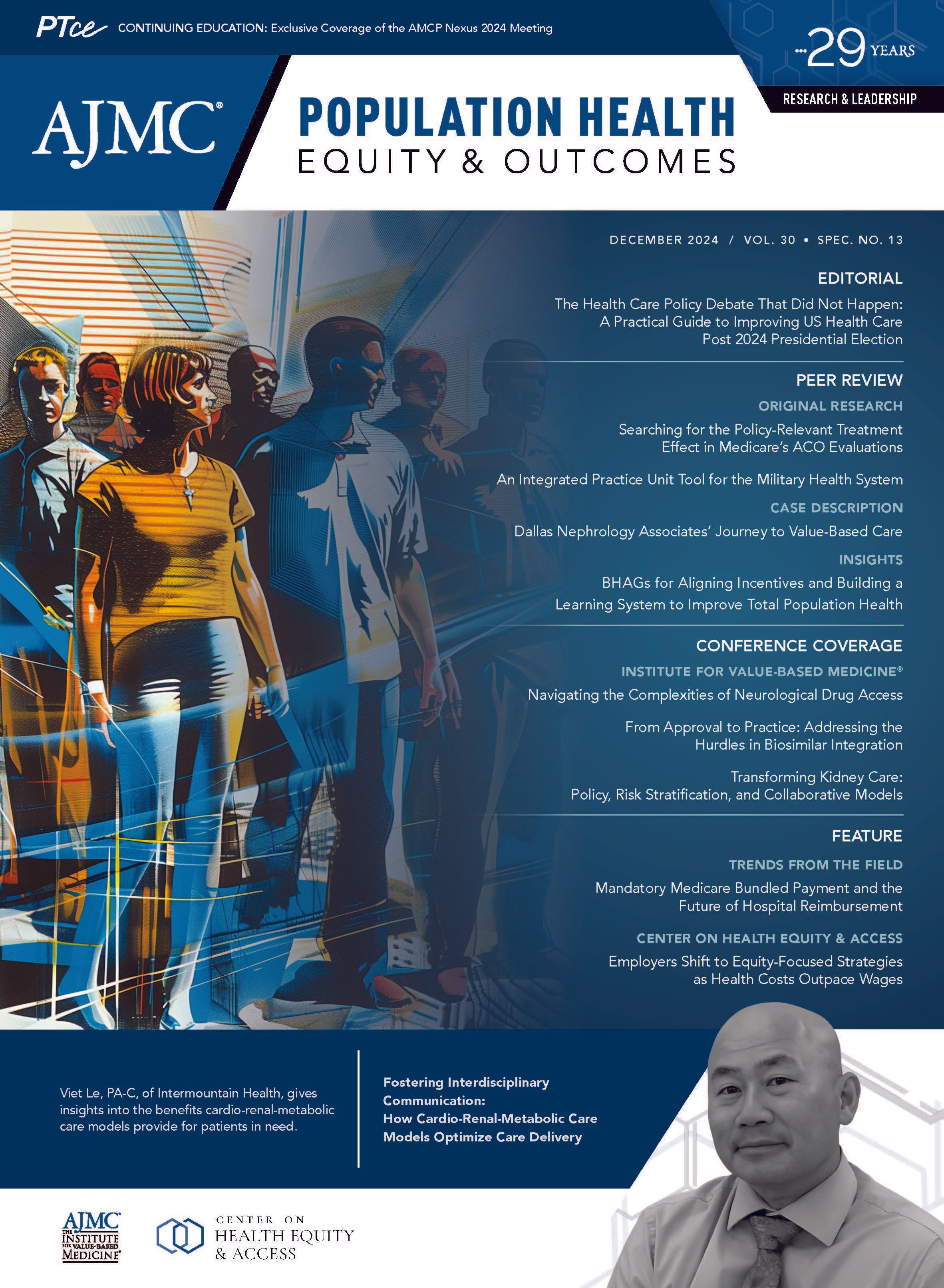Publication
Article
Population Health, Equity & Outcomes
Harnessing AI for Population Health: A Call to Action for Policy Makers and Health Care Leaders
The authors detail how artificial intelligence could be used in primary, secondary, and tertiary prevention to improve health outcomes and provide better value-based care.
The US spends considerably more on health care than any other high-income country, yet health outcomes have consistently fallen behind. In 2022, health care costs in the US reached $12,555 per person, almost double the average of comparable countries at $6651 per person.1 Such a disconnect reveals the inefficiencies within the US health care system. Integrating artificial intelligence (AI) into our health care system provides a path to address current gaps and offers a solution to our nation’s health care inefficiencies. AI is a machine-based approach that simulates the human decision-making process in learning and problem-solving. This technology has shown promise in health care in detecting, diagnosing, treating, and managing various conditions. AI can also lead to more tailored treatments or precision (personalized) medicine based on individual factors.2,3 However, concerns related to AI about keeping patients’ privacy safe and ensuring accuracy with AI usage have led to slower adoption of this technology in health care.
We believe these concerns can be overcome and that AI should be integrated into managed care to overcome the barriers to the existing health care model, thus enhancing population health. The health care system is overwhelmed by individuals with multiple chronic conditions, many of whom have type 2 diabetes (T2D). Health care professionals are getting burned out, leading to their departure and impaired quality of care. Many people do not visit their health care providers until they are sick. This leads to poor health outcomes and conditions that could have been prevented.
AI can be used in primary, secondary, and tertiary prevention to improve health outcomes and provide better value-based care. To harness the full potential of AI for improving population health, a coordinated effort must be implemented across multiple stakeholders, including health care organizations investing in AI training and AI infrastructure and CMS establishing reimbursement models—supported by Congress—for AI-driven preventive care approaches. Throughout this piece, we use diabetes as an example because it is a significant health issue affecting 11.6% of the US population. In addition, 38% of adults in the US have prediabetes.4
Primary Prevention
Primary prevention focuses on preventing or delaying the onset of diseases by promoting healthy behaviors and addressing risk factors.5 In diabetes, primary prevention emphasizes reducing the incidence of T2D. The strategy includes targeting modifiable risk factors, such as obesity, physical inactivity, and suboptimal dietary patterns, to delay or prevent the development of T2D in at-risk populations. AI can enable precise risk assessments and offer personalized recommendations on modifying lifestyle, which can be deployed at scale.
AI-driven predictive models have gained popularity for risk assessment, including their use to identify individuals at high risk for developing T2D by uncovering risk factors and associated biomarkers to devise personalized interventions. A systematic review and meta-analysis by De Silva et al explored the predictive performance of machine learning (ML) predictive modeling in T2D studies conducted in clinical and community care settings, including individuals at high risk for the condition.6 One of this review’s findings was that predictive models can be used as screening tools when applicable in community settings.
Moreover, AI contributes to primary prevention by supporting personalized recommendations on diet, exercise, and other wellness behaviors. A systematic review by Armand et al highlights various applications of AI in nutrition, including personalized and smart nutrition and predictive modeling for disease prevention, etc.7 This review proposes a conceptual framework for integrating AI, ML, and deep learning into nutrition to accomplish personalized medicine and nutrition goals (ie, preventing T2D).
The benefits of integrating AI into primary prevention can be significant at the population level. AI can enable accurate risk assessments and personalized interventions, hence preventing or delaying the onset of diabetes in sizable at-risk populations, reducing the prevalence of the condition, and alleviating the associated health care burdens.
Secondary Prevention
Secondary prevention emphasizes detecting a disease early—often before any symptoms occur—so that interventions can be implemented to stop or delay its progression and minimize the development of associated complications.5 In terms of diabetes care, secondary prevention is essential. This approach allows timely identification of diabetes diagnosis, thus reducing the risk of complications such as cardiovascular diseases and diabetic retinopathy. The integration of AI into secondary prevention has shown promising signs of improving the effectiveness of early detection and management strategies. A diabetic retinopathy screening study led by Keel et al using a deep learning algorithm found a 92.3% sensitivity and 93.7% specificity for the model’s accuracy in referring for further evaluation.8
AI tools, such as ML algorithms and predictive models, are increasingly being integrated into health care practices to analyze large data sets and to identify and stratify individuals at risk for diabetes complications. These AI models have been trained to detect subtle trends, patterns, and relationships within the data sets that may not be clear to clinicians, thus contributing to early identification of the condition. For instance, Dagliati et al led a study that applied ML methods to predict diabetes microvascular complications in people with T2D through a data mining pipeline, developing predictive models for nephropathy, neuropathy, and retinopathy based on demographics, hemoglobin A1C (HbA1C) levels, and hypertension status.9 With an emphasis on personalized risk prediction in complications related to T2D and the use of logistic regression for clinical application, the final models achieved accuracy up to 0.838.9
Integrating AI into secondary prevention can enhance early detection and intervention efforts for disease management. By facilitating more accurate risk stratification and enabling early intervention, AI can help reduce the incidence and severity of diabetes-related complications, thus potentially improving long-term health care outcomes and underscoring the need to incorporate AI strategies into standard diabetes care.
Tertiary Prevention
Tertiary prevention focuses on managing and treating chronic medical conditions to reduce complications, thus preventing further decline and enhancing the quality of life for those with such conditions.5 In diabetes care, such strategies involve glucose monitoring and complex pharmacotherapy regimens to avoid complications, such as preventing amputation in someone with T2D and peripheral arterial disease or preventing stroke in a person with T2D and cardiovascular disease. Achieving more personalized and precise care in chronic disease management is a goal of integrating AI into tertiary prevention strategies to ultimately enhance patient outcomes and health system efficiencies.
AI-driven systems have increasingly been utilized to design treatment plans. These systems can analyze vast amounts of data from various sources, such as continuous glucose monitoring devices, electronic health records (EHRs), pharmacotherapies, and other health data, aiming to provide personalized recommendations. For example, Tarumi et al implemented an EHR-integrated system to predict HbA1C changes associated with various treatment options for T2D, effectively showcasing the practicality of AI-based tools in clinical settings.10 In addition, Nagaraj et al utilized ML algorithms to predict short-term (area under the curve, 0.80; 95% CI, 0.78-0.83) and long-term (area under the curve, 0.81; 95% CI, 0.79-0.84) HbA1C responses after insulin initiation in people with T2D, outperforming previous models using baseline clinical variables.11 Such personalized approaches improve health care outcomes and empower patients to participate actively in their chronic disease management.
Addressing Limitations of AI
Although AI has the potential to transform health care delivery, several significant challenges must be addressed for safe and effective integration. As with any technology, there can be limitations. One of the key concerns is bias, relating to the data used to train an AI model or algorithm. To mitigate this problem, AI algorithms are to be trained on fair, well-represented data sets, including individuals with diverse backgrounds across racial, ethnic, socioeconomic, and geographic factors.12,13
The other challenge in the use of AI in health care is the issue of hallucinations. This phenomenon occurs when AI models, specifically large language models, generate information that is inaccurate, misleading, or entirely fabricated.14 Effectively addressing AI hallucinations will require continuous AI model refinement, improvement on AI decision-making process transparency, and consistent health care professional verification of AI outputs to ensure outputs stem from accurate data.15 It is important that humans supervise and review how the AI works and ensure that data going into AI algorithms are accurate and protected (with robust security measures when involving patient data).
Conclusion
AI has great potential to overcome many of the existing barriers in health care and could lead to a transformation in health care delivery and patient outcomes. We discussed several ways AI can be used in primary, secondary, and tertiary preventive care using T2D as an example (summarized in the Table), which is the beginning of the journey for advocating for AI integration into our health care system at a large scale. We implore policy makers and health system leaders to create payment opportunities for AI-driven efforts and to invest in AI training, education, and infrastructure to integrate AI solutions into health care delivery. The goal is to make the US a healthier country and provide the best value in health care.
Author Information
Dr Young is an associate professor and director of clinical research in the College of Osteopathic Medicine at Touro University California in Vallejo. Dr Isaacs is the director of education and training in diabetes technology at Cleveland Clinic in Ohio and a member of the editorial board of Population Health, Equity & Outcomes.
REFERENCES
- Wager E, McGough M, Rakshit S, Amin K, Cox C. How does health spending in the U.S. compare to other countries? Peterson-KFF Health System Tracker. January 23, 2024. Accessed September 4, 2024. https://bit.ly/3UOJWUf
- National Artificial Intelligence Initiative Act of 2020, HR 6216, 116th Cong (2020). Accessed September 2, 2024. https://www.congress.gov/bill/116th-congress/house-bill/6216/text
- Giorgini F, Di Dalmazi G, Diciotti S. Artificial intelligence in endocrinology: a comprehensive review. J Endocrinol Invest. 2024;47(5):1067-1082. doi:10.1007/s40618-023-02235-9
- National Diabetes Statistics Report. CDC. May 15, 2024. Accessed September 1, 2024. https://www.cdc.gov/diabetes/php/data-research/index.html
- Kisling LA, Das JM. Prevention strategies. In: StatPearls. StatPearls Publishing LLC; 2023. Accessed September 1, 2024. https://www.ncbi.nlm.nih.gov/books/NBK537222/
- De Silva K, Lee WK, Forbes A, Demmer RT, Barton C, Enticott J. Use and performance of machine learning models for type 2 diabetes prediction in community settings: a systematic review and meta-analysis. Int J Med Inform. 2020;143:104268. doi:10.1016/j.ijmedinf.2020.104268
- Armand TPT, Nfor KA, Kim JI, Kim HC. Applications of artificial intelligence, machine learning, and deep learning in nutrition: a systematic review. Nutrients. 2024;16(7):1073. doi:10.3390/nu16071073
- Keel S, Lee PY, Scheetz J, et al. Feasibility and patient acceptability of a novel artificial intelligence-based screening model for diabetic retinopathy at endocrinology outpatient services: a pilot study. Sci Rep. 2018;8(1):4330. doi:10.1038/s41598-018-22612-2
- Dagliati A, Marini S, Sacchi L, et al. Machine learning methods to predict diabetes complications. J Diabetes Sci Technol. 2018;12(2):295-302. doi:10.1177/1932296817706375
- Tarumi S, Takeuchi W, Chalkidis G, et al. Leveraging artificial intelligence to improve chronic disease care: methods and application to pharmacotherapy decision support for type-2 diabetes mellitus. Methods Inf Med. 2021;60:e32-e43. doi:10.1055/s-0041-1728757
- Nagaraj SB, Sidorenkov G, van Boven JFM, Denig P. Predicting short- and long-term glycated haemoglobin response after insulin initiation in patients with type 2 diabetes mellitus using machine-learning algorithms. Diabetes Obes Metab. 2019;21(12):2704-2711. doi:10.1111/dom.13860
- Johnson-Mann CN, Loftus TJ, Bihorac A. Equity and artificial intelligence in surgical care. JAMA Surg. 2021;156(6):509-510. doi:10.1001/jamasurg.2020.7208
- Loftus TJ, Shickel B, Ozrazgat-Baslanti T, et al. Artificial intelligence-
enabled decision support in nephrology. Nat Rev Nephrol. 2022;18(7):452-465. doi:10.1038/s41581-022-00562-3 - Mollick E. Co-Intelligence: Living and Working With AI. Penguin; 2024.
- Guan Z, Li H, Liu R, et al. Artificial intelligence in diabetes management: advancements, opportunities, and challenges. Cell Rep Med. 2023;4(10):101213. doi:10.1016/j.xcrm.2023.101213






